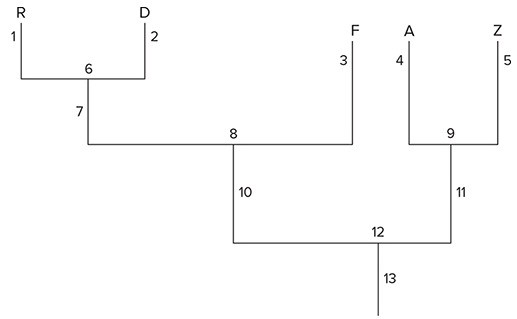Use the following informationto answer the question(s) below
Canadian and Swiss researchers wanted to know if the diversity of arbuscular mycorrhizal fungi (AMF) was important to the productivity of grasslands (M.G.A. van der Heijden, J. N. Klironomos, M. Ursic, P. Moutoglis, R. Streitwolf-Engel, T. Boler, A. Wiemken, and I. R. Sanders. 1998. Mycorrhizal fungal diversity determines plant biodiversity, ecosystem variability and productivity. Nature 396:69-72). Specifically, they wanted to know if it mattered which specific AMF species were present, or just that some type of AMF was present. They grew various plants in combination with one of four AMF species (A, B, C, & D), no AMF species (O), or all four AMF species together (A+B+C+D); and they measured plant growth under each set of conditions. All plant species were grown in each plot, so they always competed with each other with the only difference being which AMF species were present.
On the graphs below, the x-axis labels indicate the number and identity of AMF species (bar 0 = no fungi; bars A-D = individual AMF species; bar A+B+C+D = all AMF species together). The y-axis indicates the amount (grams) of plant biomass for the species shown in italics above each graph. Graph (e) is the total biomass (grams) of all 11 plant species combined; graph (f) is the biomass of Bromus erectus plants only, separated from the total.
What is the major difference between Bromus erectus (graph f) and the other plant species (graphs a-d) included in the study?
A) Bromus erectus grows best with a diversity of fungal partners.
B) Bromus erectus is unaffected by AMF diversity.
C) Bromus erectus does not form mycorrhizal associations.
D) Bromus erectus produces very little biomass regardless of AMF.
Answer: B
You might also like to view...
Bacteria that contain complex internal membrane systems are more likely to divide by budding than by binary fission
Indicate whether the statement is true or false.
Which wavelength of light penetrates through plant cover the farthest?
A) violet (400 nm) B) green (500 nm) C) red (660 nm) D) far-red (730 nm)
Which of the following is not a physical method of microbial control?
a. filtration b. radiation c. hot or cold temps d. antibiotics
 McGraw-Hill EducationThe common ancestor that produced the most evolutionary recent derived characters is
McGraw-Hill EducationThe common ancestor that produced the most evolutionary recent derived characters is
A. 12 B. 9 C. 6 D. 8